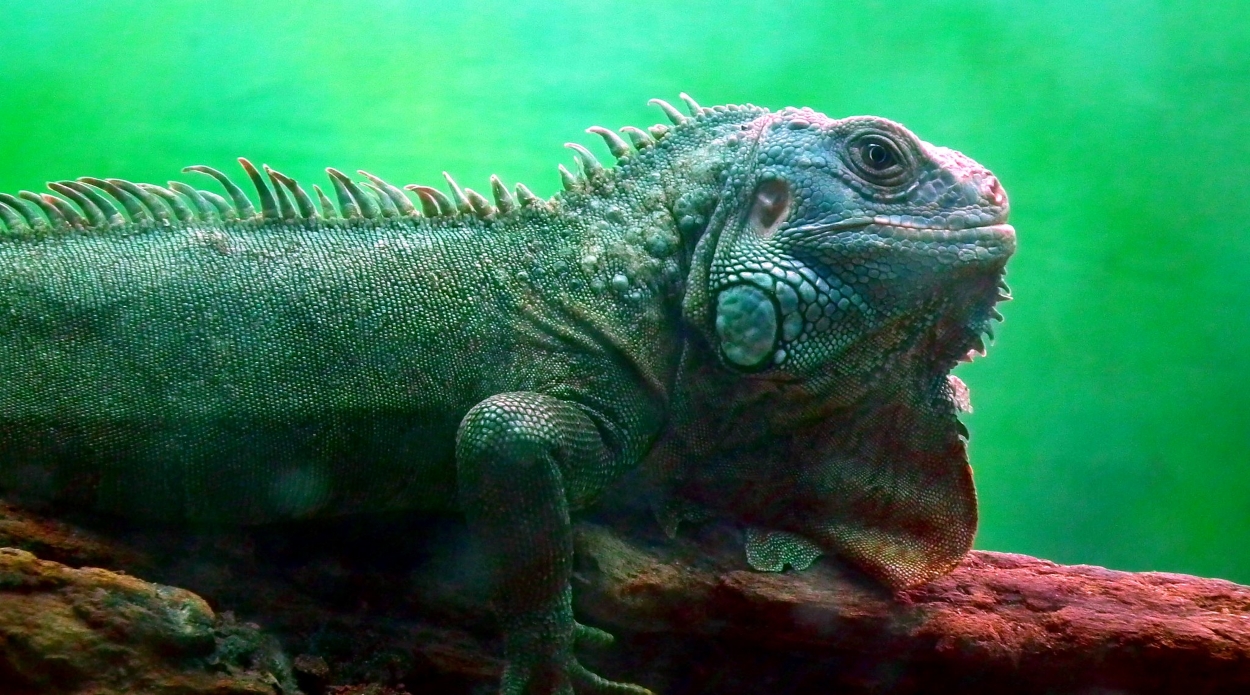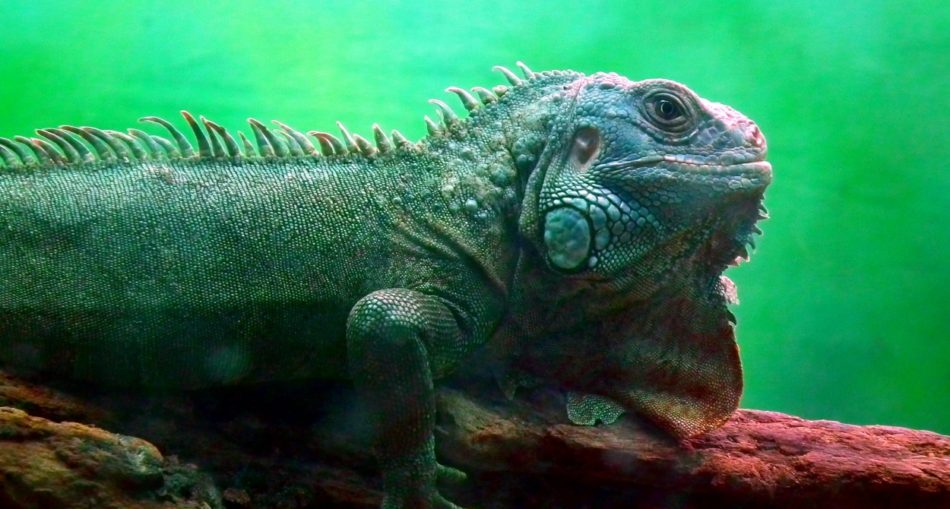The Iguana (Iguana iguana) is native to South America. It can be found from southern Brazil, Paraguay, Guyana, in countries in the Caribbean and even reaching as far north as Mexico. The Iguana was also introduced to Puerto where they are now very common. In some countries like the United States of America, Hawaii, the British Virgin Islands, they are considered an invasive species. While the reptile is simply called Iguana, it is also known as the American Iguana, “gallina de palo” which means bamboo chicken or chicken of the trees and Guana, right here in Guyana.
Iguanas are sometimes kept as pets because of their vibrant colours and calm nature. Iguanas are agile climbers though in the wet season they stick to the ground to stay warm. This reptile is an adept swimmer and uses only their tails to propel them forward with powerful strokes. Iguanas can be found abundantly in the Rupununi and Iwokrama Forest but are also found in some areas on the Low Coastal Plain, like Leguan. In Guyana, Green Iguanas are often hunted for food and a sport. You can find men and sometimes young boys with a slaughter of iguana perched on their bicycles at markets or along the roadway selling Iguanas.
Interesting Tip
- The word Iguana is of Taino (Arawak) origin, formed from “Iwana” the name of the species.
- The collection noun for Iguanas is “slaughter”.
- Leguan meaning “Land of the Iguanas” is an island on the Essequibo River.

Green Iguana – Photo by Ramesh NG – https://www.flickr.com/photos/rameshng/7705793224
Scientific Classifications Of The Iguana
- Kingdom: Animalia
- Phylum: Chordata
- Class: Reptilia
- Order: Squamata
- Suborder: Iguania
- Family: Iguanidae
- Genus: Iguana
- Species: I. iguana
Description Of The Iguana
Although one would assume Green Iguanas are green, this is not the case. In some areas like Peru, Green Iguanas are tinged with a bluish hue and have bold blue markings. Generally, Iguanas grow up to about five (5) feet in length, from head to tail and weighs about twenty (20) pounds. These iguanas have a row of spines running along their back to their tail that helps to protect from predators. Tails resemble a whip and deliver a powerful blow. Like most other lizards, iguanas are able to regenerate their tails after it has been cut or broken off. The male Green Iguana has pores on its thighs (femoral pores) that secreted a scent while those of the females are smaller. However, females also have longer and thicker dorsal spines.
Dewlaps, a fold of skin hanging just below their necks are well developed and helps in the regulating of the body temperature. Dewlaps are also important in courting and territorial displays. The Green Iguana has exceptional vision, detecting shapes and movement from long distances away and can even help to detect predators overhead. While Iguanas are primarily herbivores, they have sharp teeth that can pierce human skin. Males typically have round, large, defined jowls which are located by a large, green, circular-shaped scale called the subtympanic plate.
Interesting Tip
- The teeth of Iguanas are similar to one of the first dinosaurs discovered led to the dinosaur, named Iguanodon, meaning “iguana-tooth”.
Diet and Nutrition of The Iguana
Green Iguanas are herbivores, which means they eat only plants. Iguanas that are held in captivity are fed fruit, flowers, leafy greens, turnip greens and shoots of plants. Others in the wild also eat fruits and flowers and leaves.
Interesting Tip
- Little Iguanas sometimes eat faeces from the adults so they will obtain the essential microflora to digest their hard to process their food.
- The Green Iguana that lives in Panama has a favourite food; the wild plum.
- Iguanas do not eat citrus fruits.
Habits and LifeStyle of The Iguana
When cornered by a threat, a Green Iguana would extend and put its dewlap on display. It would stiffen and puff its body, hissing and bobbing its head at the threat. Green iguana would go to the extent of lashing at the threat with its tail and bite or claw in self-defence. Wounded iguanas are more likely to put up a fight. However if given the chance, a frightened Green Iguana will try to escape and will dive into a body of water and swim away.
Green Iguanas communicate with a combination of head bobs and dewlaps. The number of head bobs and their frequency has a different meaning to other iguanas, and are used in various social interactions like displaying territorial boundaries and courting an iguana of the opposite gender. Dominant behaviour like tail whipping and head bobbing are typically displayed by the males. They would also use their bodies to shield and protect females from predators and are the only reptiles to do so.
Reproduction Of The Iguana
The Green Iguana is oviparous, which means they reproduce by eggs, which are hatched after being laid. Females lay a clutch during the nesting season with the number of eggs ranging from twenty-one (21) to seventy (70). After about ten (10) to fifteen (15) days of incubation, the Iguana hatchlings emerge. They resemble the adults in shapes and colour but lack dorsal spines. The juvenile Green Iguana stays in their familial group for the first year of their lives. Apart from defending the nesting burrow females do not offer any parent protection after laying the eggs.
Status Of Conservation Of The Green Iguana
The Convention of International Trade of Endangered Species (CITES) lists the Iguana as an Appendix II species, which means they cannot be exported without a valid export permit. These species are also listed as threatened by the International Union for the Conservation of Nature (IUCN).
About The Iguana
Native to Guyana, the Green Iguana is one of the more common reptiles in our country. “Guana” is a delicacy and consumed locally while others are caught and exported. However, Iguanas makes great pets because of their magnificent colours and typically very calm nature. Take a trip to Iwokrama or the Rupununis and spy the Green Iguanas on limbs basking in the sunlight. Be careful though, if they notice you they may escape into the nearest body of water.
Article Reference
- https://en.wikipedia.org/wiki/Green_iguana
- https://www.stabroeknews.com/2012/01/22/features/iguana/
- https://www.newworldencyclopedia.org/entry/Iguana
- https://www.kaieteurnewsonline.com/2013/11/10/the-green-iguana/
- http://guyanachronicle.com/2017/03/19/land-of-the-iguanas








1 Comment